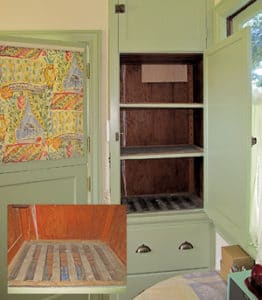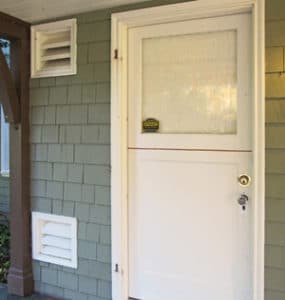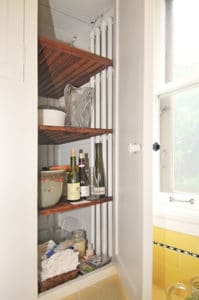If you’ve ever noticed two louvered vents stacked on the exterior of an old house, they were probably vents to a California cooler. These nifty architectural details are often associated with Craftsman Bungalow kitchens, but actually were quite common in kitchens of many different architectural styles built mostly between the early 1900s and the 1930s.
What are California Coolers?

Back in the day when iceboxes were common, the California cooler provided a bit of extra refrigeration space. Iceboxes were typically very small, and the cooler provided a dark, cool, well-ventilated space for bulky items such as potatoes, onions, carrots, fruits, and even cheeses. It was a convenient alternative to a root cellar.
This cooler has both shelves and deep drawers for cold storage in this 1932 home.
Exterior vents for the house above creates the “chimney effect” for cooling.

California coolers were located in kitchens along an exterior wall. They were enclosed storage spaces, like a small closet or a cabinet, but they had two vents for outside air. One vent was near the top of the space, and the other near the bottom. The vents usually had wire meshing to keep insects and rodents out. The coolers typically had shelves that were wooden slats with wire mesh to allow for easy airflow through the space.
These coolers worked by the “stack effect,” much like the draft of a fireplace chimney. As warmer air rises, cooler air is drawn in from the lower vent below. Some earlier coolers were vented from a cellar or a crawlspace below in order to draw cool air from there, but these tended to be more expensive to build, and exterior vents were very effective.
Why are they called California Coolers?
It has been proposed that an architect somewhere along the line thought to harness California’s temperate coastal climate, but the idea no doubt was borrowed from earlier pre-electrical refrigeration techniques.
In 1929, Robert T. Jones wrote, in the book Authentic Small Houses of the Twenties, (page 80):
“The kitchen contains a number of conveniences that will be appreciated particularly by the housewife. One of these is a California cooler or cold air box, which is a device to keep food in storage at low temperature by passing a current of outside air through apertures in the wall into a closed container built into the wall — at great savings in the ice bills.”
So how are these California Coolers, or Cold Air Boxes, relevant today?
 Well, for one thing, they can be used for the same purpose they were originally intended, the storage of root vegetables, fruits, greens, and some cheeses.
Well, for one thing, they can be used for the same purpose they were originally intended, the storage of root vegetables, fruits, greens, and some cheeses.
These cold air boxes can be used to store bottled beverages to keep them cool without taking up unnecessary refrigerator space. They can also be used to chill dishes or desserts; the list of uses is only limited by the imagination.
For those who have concerns about heat loss or drafts in the kitchen, the answer is to simply weatherize the cooler’s access door. This system of cooling is beautiful in its simplicity, as it uses the natural effect of rising warm air and the intake of cooler air from the exterior. No electricity needed! They are the ultimate green form of refrigeration.
So if you still have your California cooler, treasure it. If you lost yours to some misguided renovation, it is possible to restore it. California coolers are a charming and practical piece of your home’s architectural history.